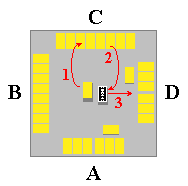Ceki decks are not easy to obtain. In case of unavailability, a good
replacement can be a
Mah Jong deck, taking out
Winds, Seasons and
Flowers, or a
Dongguan deck,
taking out the
Gui cards (see the
Chinese gallery for details
about both patterns): the pack will have 120 cards, with three suits, whose values
run from 1 to 9, plus three "special" cards, each one repeated four times.
Any number of players from 2 to 6 can take part.
A dealer, randomly chosen, shuffles the pack and asks the player on his right
to cut it. He then deals two cards to each of the players, in clockwise direction,
repeating the operation four times for a total of eight cards.
Players are not allowed to look at them until the deal has been completed.
The undealt cards are placed in a pile, face down, in the middle of the table, and
the first player (on the dealer's left) opens the game by taking his turn.
RULES OF THE GAME
Ceki is an easy game, quite similar to Mah Jong (from which
it might have originated), though its structure is more simple, and each round requires
a much shorter time to be played.
Honour cards are only worth 1 (each set scores 3 points), so the most cherished
combinations are the ones made of three 9s, worth 27.
The simple principle on which sets are built is that each player, at his turn, can
choose whether to draw a covered card from the pile, or to pick the last discard made
by a previous player. In the first case, he can decide to keep what he has found, discarding
one of the cards he already holds in hand, or to discard straight away the one he has just
drawn. Therefore, at the end of his turn, each player always remains with eight cards.
All discards must be piled in a heap, close to the uncovered cards, but only the uppermost
one (i.e. the last discard left on the table) can be taken by other players.
the couple face down 


 +
+



In case any of the two sets held in hand by the player who called ceki has the
same value as his couple (for example, he holds a set of 3's, a set of 9s, and has
a couple of 3s), he will have to lay face down not only the couple, but all five cards
of the same value, i.e. the five 3's in this example, illustrated below.
   +
+
   +
+
 
in case a player calls ceki with these cards... |
|---|
   
...he will keep in hand only the three 9s, laying face down all the 3's |
During the game, other players may call ceki, as soon as they obtain two sets
and a couple. The first player to complete three sets is the winner.
THE END OF THE GAME
When a player who has called
ceki obtains the last card he is looking for,
he turns all his cards face up, showing the three sets: he is the winner of the hand,
and the only player to score points.
- If the last card comes from the previous player's discard, it is a
plain win, only scoring the total made by
the sum of the three sets.
- If the player wins by using a card which the previous player had been holding in hand,
it is a double win, and his total is multiplied by two.
- If he wins with a card drawn directly from the pile, it is a triple win,
and his total is multiplied by three.
These three situations are summarized in the following diagrams:

PLAIN WIN
player C draws a card, but
discards it straight away (1),
enabling player D to win (2) |

DOUBLE WIN
player C keeps the card he draws (1),
thus discarding one of his (2),
which enables player D to win (3) |

TRIPLE WIN
player D draws the winning card
directly from the pile (1)
|
Therefore, as soon as a player calls ceki, all discards by the opponent
on his right become crucial: in deciding whether to keep a new card drawn from the pile,
he will have to assess the risk of an unlucky discard, which might enable the
next player not only to win, but even to double his total.
At the end of each hand, players can settle their dues, the winner receiving
from his opponents an amount of money corresponding to the points scored.
But Ceki can also be played by agreeing a total number of points: the winner
will be the player who reaches this total after a variable number of hands.
Lastly, a third scheme may be to play a given number of hands, and the winner is he
who in the end has totalized the highest score.
ENJOY THE GAME !

| this page has been visited |
 |
times |

INTRODUCTION
|

PICTURE
GALLERIES |

MULTI-LANGUAGE
GLOSSARY |

THE FOOL &
THE JOKER |

INDEX
TABLE |

PLAYING CARD
LINKS |
[an error occurred while processing this directive]
